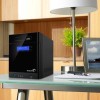Seagate Business Storage 4-Bay NAS Seagate Business Storage 1-Bay, 2-Bay, and - Page 21
Setting up Your Seagate NAS as a Media Server - business storage best 4 bay nas
 |
View all Seagate Business Storage 4-Bay NAS manuals
Add to My Manuals
Save this manual to your list of manuals |
Page 21 highlights
Customizing Your Seagate® NAS Setting up Your Seagate NAS as a Media Server Table 3 explains the different levels of RAID. Table 3: Supported RAID Levels for Volumes RAID Level of Volume Number of Disk Drives Description Required RAID 0 (Also known as striping) 2 - 4 A volume where data is distributed evenly (striped) across the disk drives in equal-sized sections. A striped volume does not maintain redundant data, and so offers no data protection. RAID 1 2 A volume where one disk drive is a mirror of the (Also known as mirroring) other (the same data is stored on each disk drive). Provides data protection. RAID 5 RAID 10 3 - 4 4 A volume with RAID 5 uses data striping and parity data to provide redundancy. (Parity is extra information that's used to re-create data if a disk drive fails. In volumes with RAID 5, parity data is striped evenly across the disk drives with the stored data.) A volume with RAID 10 is built from two or more equal-sized RAID 0 volumes. Data in a volume with RAID 10 is both striped and mirrored. Span (Also known as a JBODa) 1 - 4 A group of disk drives in a server, not protected by RAID. a.'Just a Bunch of Disks'. Seagate recommends that only users familiar and comfortable with RAID technology make changes to the server's RAID protection. Here are some available options: • Seagate 2-Bay NAS. You can choose to use RAID 0 protection, also known as "striping," where data is distributed evenly (striped) across the disk drives in equal-sized sections, and "span", also known as JBOD. RAID 0 offers no data protection; span does not provide RAID protection. • Seagate 4-Bay NAS. You can choose to use a different level of RAID protection for your volumes-your Seagate 4-Bay NAS supports RAID levels 0, 1, 5, 10, and JBOD. However, RAID 5 is highly recommended as it provides the best level of protection available on your Seagate 4-Bay NAS. Setting up Your Seagate NAS as a Media Server Set up your Seagate NAS server as a media server to stream media files to DLNA® compliant devices or computers running iTunes® software. You can set the media server to download media files into default folders automatically. You can also set up your Seagate NAS as an iTunes server so that users can stream music directly to a network attached computer with iTunes installed or to an iTunes supported device that is connected to a network computer. Seagate Business Storage NAS Administrator Guide 21















